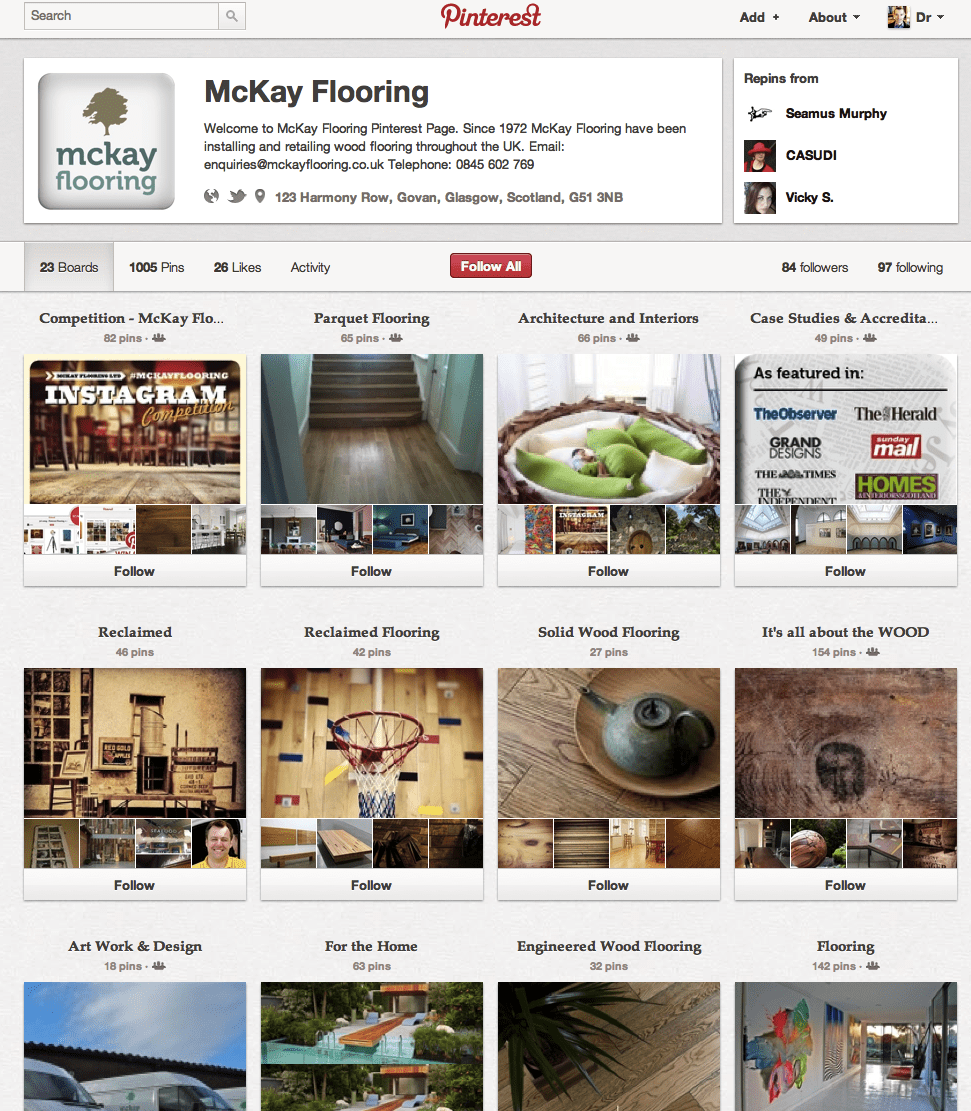3 Pinterest Marketing Case Studies to Reflect On
Even though Pinterest arrived at the scene relatively recently, it quickly made waves in the social media scene. Now that Pinterest has addressed user concerns about its Terms of Service, you should not be hesitant to use it in your social media marketing campaigns. But the question arises, how exactly should you use Pinterest to promote your business?
The idea of a Pinterest is, of course, not new. Many social bookmarking and curation websites before it allowed you to share pictures, with the same kinds of functionalities. Just before Pinterest, Instagram also made it big as a social picture sharing service. What makes Pinterest special is that it struck a nerve with the female demographic, which comprises most of its user base [source]. This is unique in the social media space, and is worth paying attention to as it means social media campaigns on Pinterest need to be handled differently than they are on other social networks.
Here are a few Pinterest marketing case studies on how the platform has been successfully utilized in social media marketing campaigns and what you need to know to start one yourself.
1) Calypso St. Barth – the Pinterest niche

Calypso St. Barth is a women’s apparel luxury brand, and one of the few brands ahead of the curve on Pinterest. They were quick to partner with Pinterest user Christine Martinez to take photos behind the scenes of their latest summer photo shoot.
The Calypso St. Barth campaign works on Pinterest because their brand matches the kind of interests Pinterest users have. They were also able to conduct the campaign in such a way that it did not seem intrusive to the existing user-generated culture prevalent within the site.
2) McKay Flooring – using Pinterest and Instagram together

Who’s to say you cannot use ‘competing’ social media services together? Not McKay Flooring, a wood flooring supply company in the UK. McKay identified the key differences between Pinterest and Instagram, and leveraged each services’ strengths in their own promotions.
In this case, when McKay Flooring observed how Instagram conveniently connects to Twitter and allows hashtags, they used the service to run a hashtag contest. On the other hand, they also noticed how Pinterest allows users to categorize their interests onto different pinboards. Consequently, McKay Flooring used Pinterest to promote brand awareness, making their Pinterest account a virtual catalog of their products, as well as connecting with other Pinterest users and even running contests.
Here, it’s important to remember that just because these networks are competing for attention does not mean you have to choose one or the other. It’s better to spread your influence across different networks and figure out how to best utilize each to your advantage.
3) Toys-R-Us: pinning from email to Pinterest

Finally, Toys-R-Us reminds us that it’s not too early to come up with innovative new ways to use Pinterest. Some marketers may be unaware or even dismissive of using email to drive people to social networks, but of course, social network accounts being email based themselves, it makes perfect sense to connect email marketing to social media marketing.
For more details on how to run campaigns on Pinterest, read the provided links. I also recommend and share the McKay Flooring case study. It goes into detail on what they have done and achieved, and gives suggestions as well.
As is true with other social networks, Pinterest is not for everyone, and there is a right way and too many wrong ways to market on it.
6 Comments
Comments are closed.
 Third Team Media
Third Team Media
Bindhurani
Pinterest is the new marketing site on the web. It was a place to pin your interesting pictures and to view it later. Nice to know about the advt campaign using this website. Thanks for sharing the link.
Third Team Media
You are most welcome Bindhurani! If you have other campaigns in mind, would love to know about them. 🙂
Daniele
Disruptive Technology is a key part of their investment strategy. They mean one and only one thing. They are referring to the theory of disruptive innovation as described by Clay Christensen in The Innovator’s Dilemma and The Innovator’s Solution (and in a half dozen other books that have followed). It describes a predictable process and pattern by which upstarts are able to introduce products to market that attack incumbents (usually) from below with inferior teognclohy targeted at low-end or less desirable segments that those that the incumbents depend on for their bread and butter. After gaining a toehold, the challenger moves upmarket to higher margin segments until they squeeze out the old and become the new dominant incumbent. There is a second form of disruptive innovation tagged new market disruption which targets non-consumers (i.e. a new market). A disruption can be low-end and new-market simultaneously.The word disruptive can be pulled out separately to mean other things that are suggestive of what the term disruptive innovation means, but that broader range of meanings has nothing to do with the VC’s investment strategy. The reason a VC would target disruption is that these are the products that displace what came before and in the long term command 40-80% market share. If 2 or 3 of every 10 investments becomes a disruptor, you will have portfolio returns that are order of magnitude greater than non-disruptive companies. Disruptors grow 10x or more faster than non-disruptors which is why the ROI on investment capital is so much greater.Google, Twitter, Microsoft, Oracle, Facebook, Apple are or were all disruptive innovators. If you were lucky enough to be an investor in all of these at their early stages, you’d be wealthier than Bill Gates or Mark Zuckerberg. That’s why investors care about disruption.In my experience, when startups describe themselves as disruptive, it’s like someone in high school telling you that they are cool. Almost by definition, they are not. Disruptive isn’t a sexy descriptor that means advanced or high tech , and if people are trying to imply that by describing themselves as disruptive, then they are misusing the term as empty hype. Being disruptive doesn’t imply advanced, or better, or breakthrough, and doesn’t even require teognclohy. It can be done with a very small incremental innovation and a new business model, for example (e.g. Netflix). And, it most certainly doesn’t convey a customer benefit, and truly disruptive innovators will be precisely targeting unmet or under-served market needs and focused on customer benefits, not whether or not they are disruptive.I suggest rather than debating what a disruptive innovation is, your readers pick up Clay’s books and learn about the theory first hand. It’s important, precisely because it has predictive value for identifying market winners and knowing why they will win.
Susan Cooper
This is a very good read regarding the power and proper use of Pinterest. I am sharing it with a few of my corporate business friends. Thank you for sharing. 🙂
Third Team Media
Hello Susan. Thanks for dropping by! Glad to know you found it useful for your friends. 🙂
Pingback:What The Heck Is Pinterest & Is It Right For My Business?